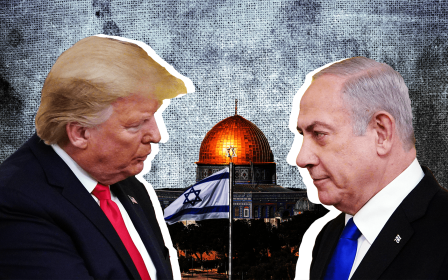'Deal of the century': Ben-Gurion's Israel turned into a Netanyahu-Trump creation

The so-called "Deal of the Century" is not just another Bill Clinton plan for the Israeli-Palestinian conflict, nor is it anything like the road map proposed by the Middle East Quartet of the UN, EU, US and Russia.
Those "peace plans" and other similar proposals popped up and disappeared into oblivion without leaving any significant mark. The "Deal of the Century", however, is different.
Some Israelis put their faith in the deal’s imminent failure. “Nothing will come of it,” they say hopefully.
They are terribly wrong.
Even at this early point, the deal has already been a consciousness-changing event for many Israelis, Jews and Palestinians alike. Before any part has been implemented, it has transformed the original Israel established under David Ben-Gurion into a Bibi-Trump creation.
The two groups most affected by the spirit of the plan are settlers and Palestinian citizens of Israel. For both, the 181 pages of the deal are an unexpected turning point - in very different ways, of course.
For the warmly-embraced settler, this is the best of times. But for Palestinian citizens who are now excluded from the closed circle of the Jewish state by a foreign superpower, it is the worst of them.
The settlers sound triumphant and rightfully so. And yes, they continue to have their reservations and refuse to countenance anything resembling a Palestinian state, even Trump’s notion of one.
But something more important has happened to them: for the first time since the 1967 Middle East war and after 52 years of occupation, they are no longer perceived as an “obstacle to peace”. Instead, they are embraced by the Trump administration and have finally "settled in the hearts", their own description of the project they have been trying to implement for decades.
The right-wing publicist, Emily Amrousi, who formerly served as the spokesperson for the Yesha Council, the umbrella organisation of settlers’ local councils, said it best.
'For first time, we are not perceived as occupiers of our own land'
- Emily Amrousi, Israeli publicist
Raving about the deal on her Friday radio show, she proudly announced: “The Six Day War has finally come to an end…President Trump said the words I longed to hear...For the first time, we are not perceived as occupiers of our own land. In the Oslo accords, we were the weak ones, asking the Palestinians to take it all - just not to kill us…Now we are the strong ones and they need to make concessions...It is not the tanks but rather the bulldozers that mark the borders. Finally, it is the mirror image of Oslo.”
Many other right-wing writers and analysts say the same albeit in less poetic language. Mordechai Kedar, a scholar of Arabic culture at Bar-Ilan University and a former high-ranking military intelligence officer known for his outrageous far-right ideas, wrote on his Facebook page: “From the river to the sea, Palestine will be free from the Islamic-Arab occupation.”
This widespread sentiment is here to stay despite the fact that the Yesha Council vocally rejects the deal. Empowerment does not necessarily depend on the end result. It is a state of mind.
Lieberman's role
The same can be said about the part of the plan referring to the exchange of territorial control of the Wadi Ara region in the north, also referred to as the Triangle, in exchange for the territory in the southern hills of Hebron.
Territorial exchange? We are talking about people. Currently, 350,000 Palestinian citizens of Israel live in the area to be detached from Israel and given to what will probably become the future Palestinian state.
The plan is not new. The mastermind behind it is MK Avigdor Lieberman, head of Yisrael Beiteinu, who adopted it as part of his campaign agenda in the 2006 elections. A senior source close to Lieberman told Middle East Eye that behind the scenes, Lieberman was instrumental in making sure the concept was in the final version of the deal.
According to the source, who is an adviser to Lieberman, Lieberman held a series of meetings with Jason Greenblatt, Trump’s former Middle East envoy.
The source says Lieberman sees the exchange as a move of utter importance although it means “getting rid” of 350,000 Palestinians. Lieberman's aim, he said, is to undermine the political power of the “fifth column” – as he refers to Palestinian political representation - and thus bring about a mental and conceptual change in the already weakened Palestinian minority in Israel.
Lieberman might be right. His original more-than-decade-old plan damaged the Palestinian community inside Israel, spreading anger and fear over their uncertain future. But it runs much deeper when it becomes part of a deal sanctified by an American administration.
It is no longer just a whim of a racist politician. It is policy. The feeling of being pushed, literally, behind the fence is not going to heal even if its implementation is “not feasible”. It is right there, a paragraph on one of the 181 pages.
Reversal of history
The very reference to Wadi Ara as an area that is no longer a necessary part of Israel is quite a twist in the history of the state.
After the state’s establishment in 1948, David Ben-Gurion fought long and hard until he was able to get the area which he deemed crucial for Israel from the Jordanians under the 1949 armistice agreement. Now the land and its people are obsolete.
So are parts of the Negev, the southern part of Israel bordering Egypt. Ben-Gurion, the long-ruling prime minister to whom Netanyahu compares himself, saw the Negev as crucial to the future of Israel.
In 1955, he wrote, “The Negev is the cradle of our nation, it’s the most dangerous part of the state but its biggest hope, too. The Negev land will be the ultimate test to the people of Israel and their state.”
'I fail to believe any Israeli security organs saw that map prior to its publication'
- Assaf Orion, retired Israeli brigadier general
The Trump plan will swap populated land in the Negev, bordering on Egypt, with areas in the West Bank to build bridges and tunnels to connect enclaves formed in the new Trump plan.
At a recent conference held by the Tel Aviv-based Institute for National Security Studies (INSS), which was dedicated to the next decade of the region, Assaf Orion, a retired Israeli brigadier general who is now senior research fellow at INSS and international fellow with the Washington Institute for Near East Policy, was critical of that move.
Orion told MEE: “I fail to believe any Israeli security organs saw that map prior to its publication. In fact, they were taken by surprise when they first saw it.
"If implemented, Israel loses the necessary strategic depth, the kind of small 'Gaza Strip' on the Egyptian border that facilitates the movement of hostile elements. That creates a problem to us, the population there and to Egypt. That is what it looks like when a map is drawn by a small circle close to Trump and Bibi”.
Nothing will come out of it? Maybe. But the damage caused by the very publication is here to stay, long before the good some see in the plan can counterbalance the bad.
Middle East Eye delivers independent and unrivalled coverage and analysis of the Middle East, North Africa and beyond. To learn more about republishing this content and the associated fees, please fill out this form. More about MEE can be found here.





